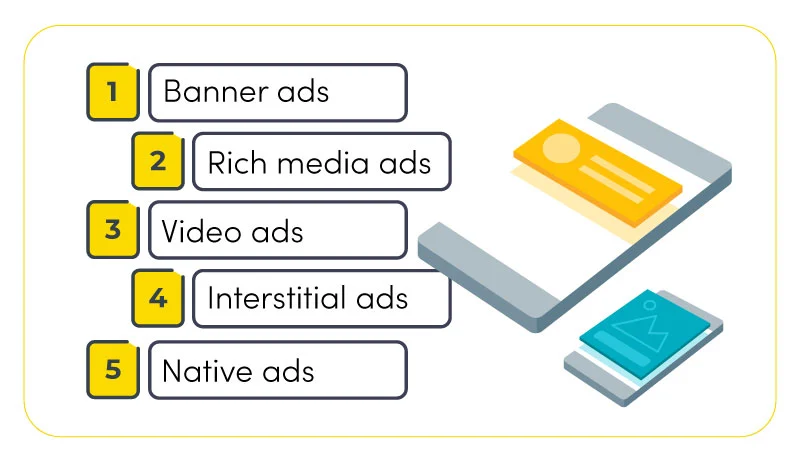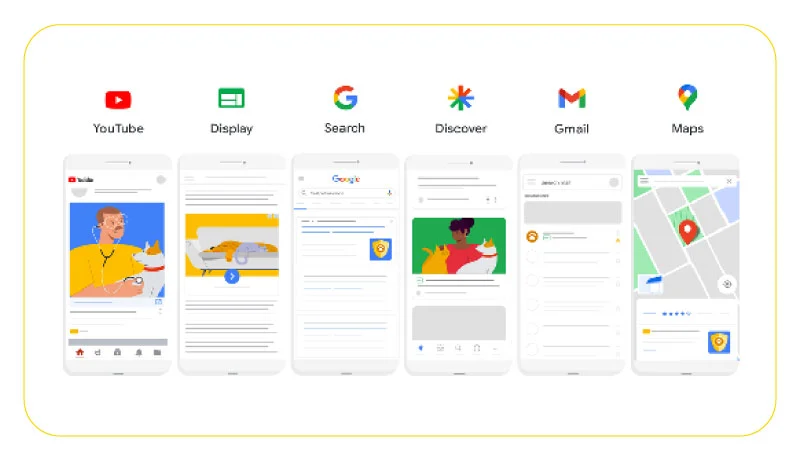What is display advertising? In today’s digital landscape, where businesses strive to capture the attention of their target audience, display advertising plays a vital role. It refers to the practice of promoting products, services, or brands through visually appealing advertisements displayed on various websites, social media platforms, mobile apps, and other digital channels. Display advertising encompasses a diverse range of ad formats, targeting options, and measurement techniques that enable advertisers to reach their desired audience with precision and creativity.

By harnessing the power of captivating visuals and strategic ad placement, display advertising offers businesses the opportunity to increase brand visibility, engage with potential customers, and drive conversions. In this article, we will explore the key components of display advertising, its benefits, comparisons with other advertising formats, effective strategies, prominent networks and platforms, essential metrics for measurement, and future trends shaping its evolution.
Key Components of Display Advertising
Display advertising encompasses several key components that work together to create effective and engaging ad campaigns. Understanding these components is crucial for advertisers and publishers alike. Let’s dive into the fundamental elements that drive the success of display advertising:
Advertisers and Publishers
At the heart of display advertising are two key players: advertisers and publishers. Advertisers are businesses or individuals seeking to promote their products, services, or brand. They invest in display advertising to reach their target audience and drive desired actions, such as website visits or product purchases.
On the other side, publishers own the digital spaces where advertisements are displayed. These spaces can be websites, mobile apps, social media platforms, or other digital channels. Publishers provide ad inventory, allowing advertisers to showcase their ads to a relevant audience.

Ad Formats and Placement
Display advertising offers a wide array of ad formats to capture audience attention and convey messages effectively. These formats include banner ads, rich media ads, video ads, interstitial ads, and native ads. Banner ads, displayed as rectangular images or texts, are among the most common formats.

Rich media ads, on the other hand, provide interactive and engaging experiences, often featuring multimedia elements like videos, animations, or interactive games. Ad placement refers to the strategic positioning of ads on publisher websites or platforms. Placement options can range from above-the-fold positions, where ads are visible without scrolling, to specific sections or pages relevant to the advertiser’s target audience.
Targeting Options
One of the significant advantages of display advertising is its ability to target specific audiences. Advertisers can leverage various targeting options to ensure their ads are shown to the right people at the right time. Demographic targeting allows advertisers to reach audiences based on factors such as age, gender, location, or income level. Behavioral targeting focuses on users’ online behavior, considering their browsing history, interests, or previous interactions with the brand. Contextual targeting displays ads on websites or platforms relevant to the ad’s content, ensuring contextual relevance. Additionally, remarketing enables advertisers to target users who have previously interacted with their website or shown interest in their products or services.
Tracking and Measurement
To measure the effectiveness and optimize display advertising campaigns, tracking and measurement play a vital role. Advertisers utilize tracking pixels or tags placed on their ads to collect data on impressions, clicks, conversions, and other key metrics. This data enables advertisers to assess the performance of their campaigns, make data-driven decisions, and refine their targeting and messaging strategies. Additionally, conversion tracking allows advertisers to track specific actions taken by users, such as purchases or sign-ups, attributing them to their display ads. Robust tracking and measurement tools provide valuable insights into campaign performance, enabling advertisers to maximize their return on investment.
By understanding and harnessing these key components of display advertising, advertisers can create compelling campaigns that effectively engage their target audience. Publishers, on the other hand, can leverage these components to optimize ad placements and generate revenue.
Pros and Cons of Display Advertising
Display advertising offers a plethora of advantages that make it a popular choice among advertisers. However, it’s important to recognize that along with its benefits, display advertising also comes with a few limitations. Let’s explore the advantages and disadvantages of display advertising:
| Advantages | Disadvantages |
|---|---|
| Increased Brand Visibility | Ad Blindness and Ad Blockers |
| Wide Reach and Audience Targeting | Ad Viewability and Fraud |
| Creative and Interactive Ad Formats | Limited Message Retention |
| Remarketing and Conversion Tracking | Ad Fatigue |
| Cost-Effective Advertising |
Advantages:
- Increased Brand Visibility: Display advertising allows businesses to enhance their brand visibility by reaching a wide audience across various digital platforms. With visually appealing ads placed strategically, brands can capture the attention of potential customers and create lasting impressions.
- Wide Reach and Audience Targeting: Display advertising provides access to a vast network of websites, apps, and social media platforms, enabling advertisers to reach their target audience on a global scale. Furthermore, the ability to target specific demographics, interests, and behaviors ensures that ads are shown to the most relevant users, increasing the chances of engagement and conversions.
- Creative and Interactive Ad Formats: Display advertising offers a range of ad formats, including rich media and interactive elements. These formats allow advertisers to unleash their creativity and deliver immersive brand experiences. Engaging users with interactive elements, such as videos, games, or interactive product showcases, can significantly increase brand recall and user engagement.
- Remarketing and Conversion Tracking: Display advertising enables remarketing, a powerful technique that targets users who have previously interacted with a brand’s website or shown interest in their products. By serving personalized ads to these users, businesses can nurture leads, increase conversions, and reinforce brand awareness.
- Cost-Effective Advertising: Compared to traditional advertising channels like television or print, display advertising can be more cost-effective, especially for small and medium-sized businesses. Advertisers have the flexibility to set budgets, bid options, and payment models that align with their goals, ensuring efficient use of their advertising budget.

Disadvantages:
- Ad Blindness and Ad Blockers: With the increasing exposure to online ads, users have developed ad blindness, where they consciously or unconsciously ignore display ads. Additionally, the rise of ad blockers poses a challenge to advertisers, as these tools prevent ads from being displayed to users who have installed them.
- Ad Viewability and Fraud: Ensuring ad viewability, where ads are actually seen by users, can be a concern in display advertising. Ad fraud, such as fake impressions or clicks, can distort campaign performance and waste advertising budgets. Advertisers must employ measures to minimize fraud and ensure that their ads are reaching genuine users.
- Limited Message Retention: Display ads often have limited space and time to convey a brand’s message effectively. Users may only see an ad for a brief moment, reducing the opportunity for deep engagement or message retention. Advertisers must carefully craft concise and impactful ad creative to make a lasting impression on viewers.
- Ad Fatigue: Displaying the same ads repeatedly to users can lead to ad fatigue, where users become disengaged or irritated by the repetitive content. Advertisers need to carefully manage ad frequency and rotation to maintain user interest and avoid negative brand perceptions.
While display advertising brings numerous advantages, it’s essential to address the associated challenges to ensure optimal campaign performance. By leveraging its strengths and mitigating its limitations, businesses can leverage display advertising as a powerful tool to achieve their marketing objectives.
Google Display Network
When it comes to display advertising, there are several prominent networks and platforms that advertisers can utilize to reach their target audience effectively. One such network that stands out is Google Display Network (GDN). So, what is Google Display? It is an extensive network of websites, mobile apps, and other digital platforms where advertisers can display their ads to a vast audience. With millions of websites and apps in its network, Google Display offers unparalleled reach and targeting capabilities.

Google Display allows advertisers to reach users at different stages of their online journey. Whether they are researching a product, reading articles, watching videos, or checking their favorite blogs, advertisers can showcase their ads across a wide range of online properties. This expansive reach ensures that advertisers can connect with their target audience wherever they spend their time online. Make sure to check out a Google Display guide to deepen your knowledge of this important marketing channel.
Conclusion
In conclusion, what is display advertising? It is a dynamic and versatile form of digital advertising that allows businesses to showcase their products, services, and brand messages through visually appealing ads across various websites, mobile apps, and digital platforms. Display advertising encompasses a wide range of ad formats, targeting options, and measurement techniques that enable advertisers to connect with their target audience effectively.
By leveraging the power of captivating visuals, precise targeting, and strategic ad placement, display advertising offers businesses the opportunity to increase brand visibility, engage with potential customers, and drive conversions. As the digital landscape continues to evolve, display advertising remains a crucial component of a comprehensive marketing strategy. By understanding its key components, benefits, strategies, and the evolving trends in the industry, advertisers can harness the full potential of display advertising to achieve their marketing goals and stay ahead in a competitive digital world.
FAQs
What is display advertising?
Display advertising refers to the practice of promoting products, services, or brands through visually appealing ads displayed on websites, mobile apps, and digital platforms.
How does display advertising work?
Display advertising works by advertisers placing their ads on websites or platforms within a network. These ads can be targeted based on factors such as demographics, interests, or browsing behavior to reach the desired audience effectively.
What are the benefits of using display advertising?
The benefits of using display advertising include increased brand visibility, wide audience reach, creative and interactive ad formats, remarketing capabilities, and cost-effective advertising options.
What is the purpose of display marketing?
The purpose of display marketing is to raise brand awareness, engage with the target audience, drive conversions, and promote products or services effectively using visually compelling ads displayed on various digital platforms.







 Facebook Ads Spy Tool
Facebook Ads Spy Tool TikTok Ads Spy Tool
TikTok Ads Spy Tool